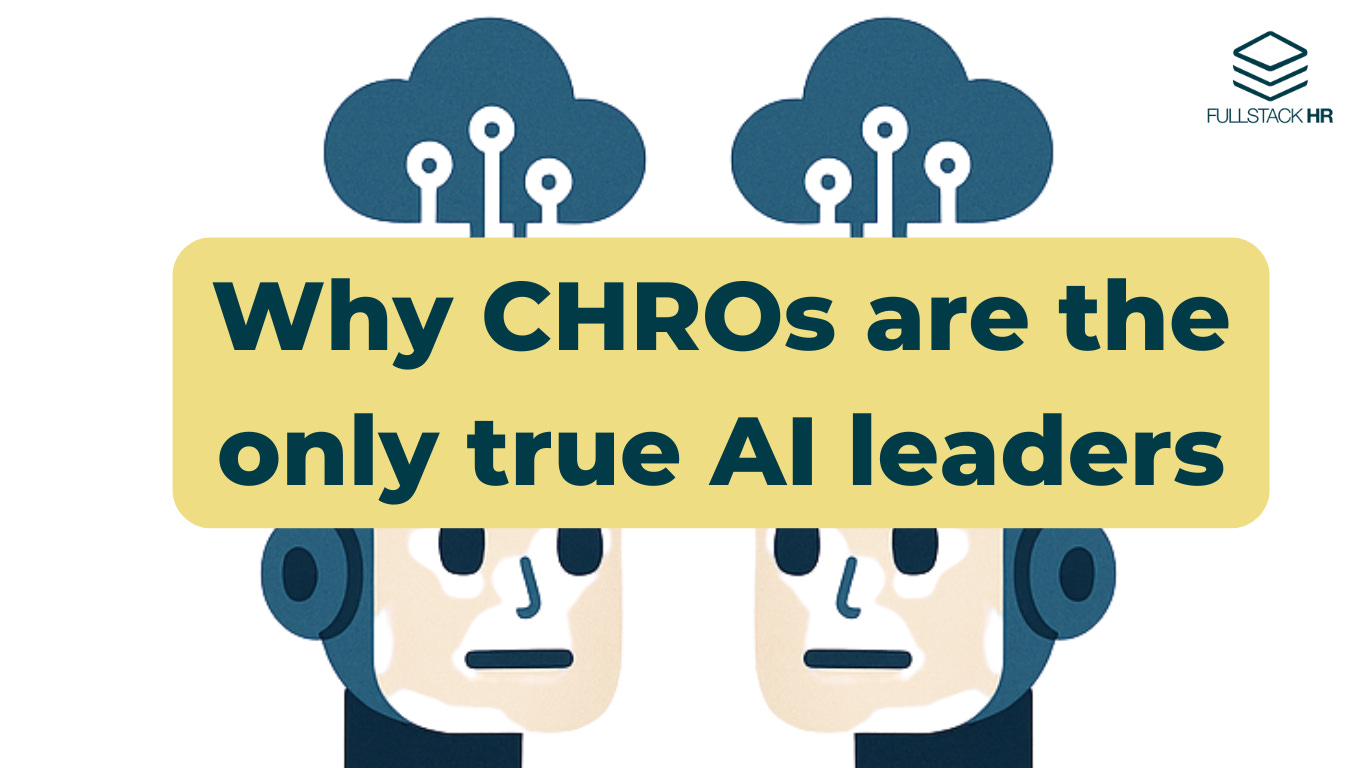Why CHROs are the only true AI leaders
While your CEO panics about AI, you're secretly winning
Welcome to FullStack HR, and an extra welcome to the 13 people who have signed up since last edition.
If you haven’t yet subscribed, join the 9600+ smart, curious and like-minded future of work people by subscribing here:
If you're reading this, you've likely felt it, that nagging sensation that everyone else is ahead of you in the AI race. Your colleagues mention their ChatGPT workflows, your CEO asks about "AI strategy," and you're still figuring out whether to be worried or excited about artificial intelligence.
You're not alone. In my conversations with organizations across the spectrum, from small municipalities to large global companies, I've found that "almost everyone I talk to has a constant feeling of being 'late.'" Most organizations sit at roughly the same level, yet this universal anxiety persists.
Here's what most HR leaders don't realize: that feeling of being "behind" isn't a weakness. It's your greatest strategic advantage.
Why "Being Behind" Is Your Superpower
While others rush to implement AI tools or panic about being left behind, CHROs are positioned in the most valuable spot in their organizations. As a CHRO, you're the only person who must understand and navigate three different time zones simultaneously:
The Past Zone - Your organization's established processes, traditional workflows, and institutional wisdom. Employees here aren't resistant; they're guardians of stability and continuity.
The Present Zone - Where most of your workforce operates, dealing with immediate pressures and today's challenges. They need to see clear, immediate benefits from AI tools.
The Future Zone - Your early adopters who are already experimenting with AI tools, often secretly. They're the ones turning 4-hour presentations into 20-minute tasks while keeping the time savings to themselves. These productivity gains stay with individuals, not the organization, creating a hidden economy of efficiency that leadership never sees.
While your CTO focuses on future possibilities and operations managers drown in present realities, CHROs are the only leaders who can build bridges between all three time zones.
The Time Traveler Framework
Mastering Each Zone
In the Past Zone: Become an organizational anthropologist. Understand not just what people did, but why those approaches worked. Help AI implementations build on existing strengths rather than replacing them wholesale.
In the Present Zone: Focus on translation and immediate value. Show employees how AI tools solve today's problems. Make AI feel like a natural extension of existing capabilities, not a replacement for human judgment.
In the Future Zone: Identify your early adopters and legitimize their innovations. Create safe spaces for them to share discoveries and develop systems for scaling their work across the organization.
Send this to any CHRO who needs to hear that they're not behind, they're strategically positioned.
Your Practical Toolkit
Week 1: Conduct Your Temporal Assessment
Survey employees about technology comfort and workplace challenges
Map which temporal zone different teams operate in
Identify natural bridges and potential friction points
Week 2: Find Your Early Adopters
Systematically identify employees already using AI tools
Create safe channels for sharing AI usage without penalty
Document the "hidden AI economy" in your organization
Week 3: Build Temporal Bridges
Launch pilot mentorship programs pairing employees from different zones
Create structured learning activities that leverage different perspectives
Establish regular check-ins to capture insights
Week 4: Establish Your Leadership Platform
Position yourself as the expert on AI's human impact
Create regular communications sharing AI adoption insights
Build partnerships with other leaders based on your temporal intelligence
Taking Control: From Reactive to Proactive
Your authority as an AI leader doesn't come from technical expertise. It comes from understanding organizational behavior and change management. These skills are more crucial for AI success than any technical knowledge.
Most organizations "stick their heads in the sand on AI literacy training, assuming people will figure it out." This is your opportunity. The organizations that figure out how to do AI literacy training at scale will be the ones coming out stronger from this change.
Create AI readiness by developing organizational literacy that goes beyond tool training. Build psychological safety around AI experimentation. Transform individual productivity gains into organizational advantages through systematic "innovation harvesting."
Build bridges between different technological cultures in your organization. Translate between groups, create cross-cultural communication opportunities, and facilitate collaborative problem-solving that leverages each zone's strengths.
Your Next Steps
The transformation from feeling behind to leading AI implementation begins with recognizing your unique position. You're not behind. You're exactly where you need to be to guide your organization through the complex human challenges of AI adoption.
Remember: The future belongs not to organizations with the most advanced AI technology, but to those with leaders who can effectively navigate the human side of AI transformation. As a CHRO and organizational time traveler, you're uniquely positioned to be that leader.
Know a CHRO who's feeling overwhelmed by AI? They're not behind, they're perfectly positioned to lead. And yes, you should forward this article to show them why their unique perspective is exactly what their organization needs right now.


